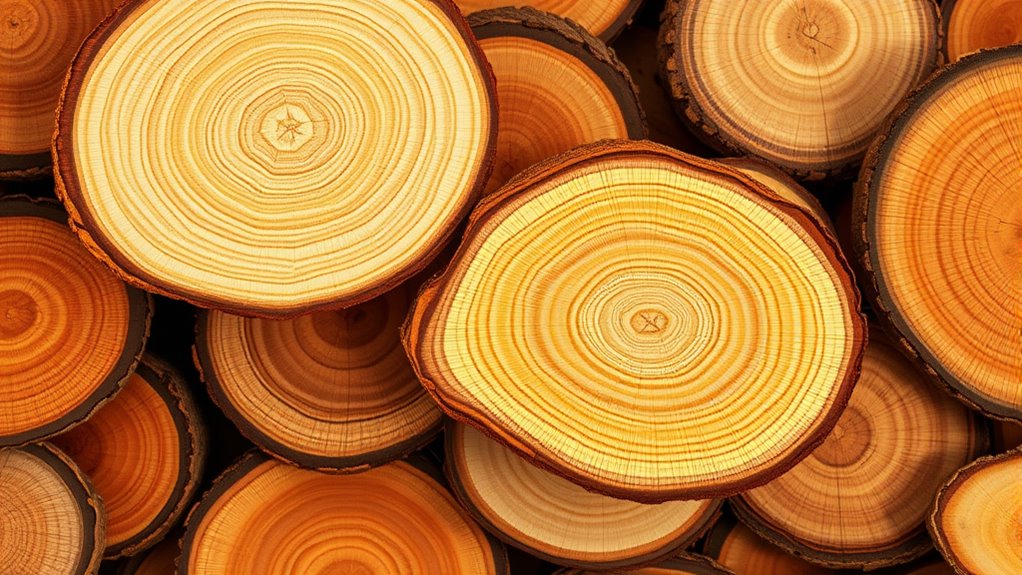When choosing wood for turning, consider how each species’ qualities suit your project. Maple offers a smooth, uniform grain perfect for a polished look, while cherry provides a warm tone that develops a rich patina over time. Other woods like walnut or exotic species can add striking character or color. Matching the wood’s workability and style to your project guarantees great results. Keep exploring to discover which species best fits your turning needs.
Key Takeaways
- Match wood grain and finishability with project design for optimal aesthetics and smoothness.
- Choose Maple for fine, uniform grain ideal for smooth carving and durable, polished surfaces.
- Select Cherry for warm color, easy turning, and developing a rich patina over time.
- Consider exotic woods for bold grain and vibrant hues, but prepare for special finishing needs.
- Match wood species to project purpose, ensuring durability, appearance, and ease of workability.

Selecting the right wood is essential for successful turning projects because it directly affects the workability, finish, and durability of your piece. When choosing wood, you want to consider how its grain patterns will influence the final appearance and how easily you can apply finishing techniques to enhance its natural beauty. Different species like maple, cherry, and others offer unique characteristics that can make or break your project, so understanding their properties helps you make an informed decision.
Maple is a popular choice for turning because of its fine, uniform grain patterns. Its smooth grain makes it easier to carve and shape, giving you a clean, polished look with minimal effort. Maple also responds well to finishing techniques, absorbing stains and finishes evenly, which allows you to achieve a professional appearance. Its durability and resistance to wear make it ideal for functional items like bowls, handles, or turnings that will see regular use. Keep in mind that maple’s tight grain may require some extra sanding to eliminate any minor ridges, but once polished, it reveals a bright, almost reflective surface that highlights its subtle grain patterns.
Maple’s fine, uniform grain ensures easy carving, a polished finish, and durable, functional turnings.
Cherry wood offers a different aesthetic with its warm, reddish hue and similar fine grain patterns. It’s known for its ease of turning, which makes it a favorite among woodturners of all skill levels. Cherry also takes finishing techniques beautifully, developing a rich patina over time that enhances its natural color and grain. Its smooth grain pattern lends itself well to detailed work, allowing you to highlight intricate carvings or smooth curves. Because cherry ages gracefully, it’s a good choice if you want a piece that gains character and depth with age. Be aware, though, that cherry can sometimes have irregular grain patterns or slight variations, which add visual interest but may require careful planning during your project.
Other species like walnut, beech, or exotic woods each come with their own grain patterns, workability, and finishing characteristics. Walnut’s dark, dramatic grain makes it striking for decorative pieces, while beech offers a lighter tone with a consistent grain, suitable for a variety of projects. Exotic woods often feature bold grain patterns and colors but may require special finishing techniques to bring out their full potential.
Choosing the right wood means matching its grain patterns and finishing techniques to your project’s desired look and function. By understanding these factors, you can select a species that not only turns well but also showcases its natural beauty and durability, ensuring your project is both stunning and long-lasting.
Frequently Asked Questions
Which Wood Species Are Most Eco-Friendly for Turning?
You should choose woods from sustainable forestry practices, like bamboo, cork, or reclaimed wood, for eco-friendly turning. These options reduce environmental impact and support conservation efforts. Using eco-friendly finishes further minimizes toxins and pollutants. By selecting responsibly harvested or recycled materials, you help protect forests and promote sustainable practices, making your turning projects not only beautiful but also environmentally conscious.
How Does Wood Moisture Content Affect Turning Quality?
Think of wood moisture content as the fuel for your turning fire. If it’s too wet, your project warps or cracks; if too dry, it splinters. Accurate moisture measurement helps you determine the right drying techniques, ensuring stable, smooth turns. For example, I once used a moisture meter, and the difference between a rough and polished finish was striking. Proper moisture control makes your turning safer and more satisfying.
Are There Specific Safety Precautions for Turning Exotic Woods?
When turning exotic woods, you should always wear proper safety gear like masks, goggles, and hearing protection to avoid dust inhalation and debris. Make certain dust control by using a dust collection system or vacuum to minimize airborne particles. Exotic woods can contain toxins or irritants, so handling them carefully and working in a well-ventilated area is essential to stay safe during your turning projects.
How Does Wood Grain Direction Influence Turning Results?
Coincidence often reveals how wood grain direction impacts your turning. When you align your tool cutting direction with the grain orientation, you achieve smoother cuts and reduce tear-out. Turning against the grain can cause chipping and rough surfaces, so pay close attention to grain flow. By understanding this relationship, you control the finish quality and minimize tool strain, making your project safer and more professional-looking.
Can Recycled or Reclaimed Wood Be Safely Used for Turning?
Yes, you can safely use recycled or reclaimed wood for turning. Just make sure you thoroughly inspect the wood for stability, pests, or mold. Always wear safety gear like goggles and a dust mask, and keep your tools sharp and well-maintained to prevent accidents. Properly drying and prepping reclaimed wood guarantees safer, smoother turning, minimizing risks from unexpected knots or soft spots.
Conclusion
Ultimately, choosing the right wood for turning is like selecting the perfect brush for a masterpiece—each species brings its own character and charm. Whether you prefer the bright clarity of maple or the warm richness of cherry, your choice shapes your creation. So, trust your instincts, embrace the variety, and let your passion guide you. After all, in the world of turning, your favorite wood is the key to unleashing endless artistic possibilities.









